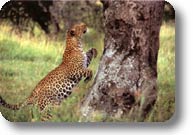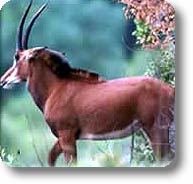|
Points of Interest
|
|
Wildlife
|



|
Mammals
As the only Kenyan habitat of the magnificent Sable antelope (Hippotragus niger), visit the central grasslands of Buffalo Ridge, Marere Circuit and around the old airstrip to best ensure your Sable sightings. The jet-black males with their scimitar-shaped horns are stunning, while the dark-reddish-brown groups of females are difficult to miss. In the forests, roam herds of African elephants along with black and white colobus monkeys and the noisy, nocturnal greater galagos (bushbabies). Carnivores include leopard, serval and both striped and spotted hyena. The rare golden rumped elephant shrew also lives in the forests as do bush duiker and bushbuck. These and other creatures are regular visitors to the Shimba Hills Rainforest Lodge.
Birds
The reserve offers rich avian fauna. Coastal forest specialities include the lovely Fischer’s turaco, Narina trogon, red-tailed ant-thrush and east-coast akalat. The magnificent African crowned eagle can sometimes be seen soaring over the canopy, while the swooping fish eagle circles river and waterhole spots. The palm-nut vulture, an unusual vulture that feeds on the fruits of palm-trees, has been seen in the park. The striking, iridescent Uluguru violet-backed sunbird flits among forest flowers and boldly-coloured, but shy four-coloured bush-shrike skulks in the tangled shadows. Its cousin, the plain-backed sunbird, is also found in the Park. |
Reptiles and Amphibians
|
This coastal forest, being hot and wet, is particularly rich in reptile and amphibian species. Slithering snakes include the lemony-leaf-coloured green mamba, a shy forest dweller and the also venomous spitting cobra! African rock pythons lurk in the shade of rocky outcrops, while the superbly camouflaged puff adder lies patiently in wait for prey.
The confiding white-headed dwarf gecko is common; watch it sunning itself at the lodge! The rarer Usambara forest gecko is an arboreal species endemic to East Africa’s coastal forests. Endemic frog species include Afrixalus sylvaticus and Hyperlius rubrovermiculatus. |
|
Insects
|
|
As coastal forests are rich in butterflies, about 35% of Kenya’s butterfly species occur in Shimba Hills. These include the rare Acraea aubyni, an orange-and-black butterfly that flies slowly, high above the ground. Roger’s sailer butterfly is another endemic species with a bold black and white pattern and crisp, sailing flight. Swallowtail butterflies abound including the nervous Papilio constantinus and numerous swordtail butterflies that gather in flocks at roadside puddles. Walking along the trail to Sheldrick’s Falls, watch for the large red-legged millipedes. Up to a foot long, they are hard to miss! Their constant churning of forest-floor litter generates much-needed humus and keeps the forest soils aerated. |
|
Plants
|
|
The Shimba Hills are cloaked in a mantle of ancient forests, one of the largest contiguous pieces in East Africa. Over a thousand species of plants have been recorded - a fourth of them endemic to this area. These forests are very ancient; they are part of the Eastern-Arc forests that reach from the Taita Hills in Kenya into Tanzania. Spared the ravages of the last ice-age, these forests were a refuge for numerous species over the millennia. Among the survivors are the cycads, palm-like plants of the forest undergrowth. Cycads are unmistakable with a rosette of palm-like leaves radiating in a symmetrical fan from a short knobbly, encrusted trunk. With a lineage of over 200 million years, the cycads have watched even the dinosaurs come and go!
The humid forests are perfect for orchids, with dozens of species dripping from the gnarled limbs of forest trees. Lovely terrestrial orchids may be found in the grassy glades to include some of Kenya's most striking eulophia species. |

